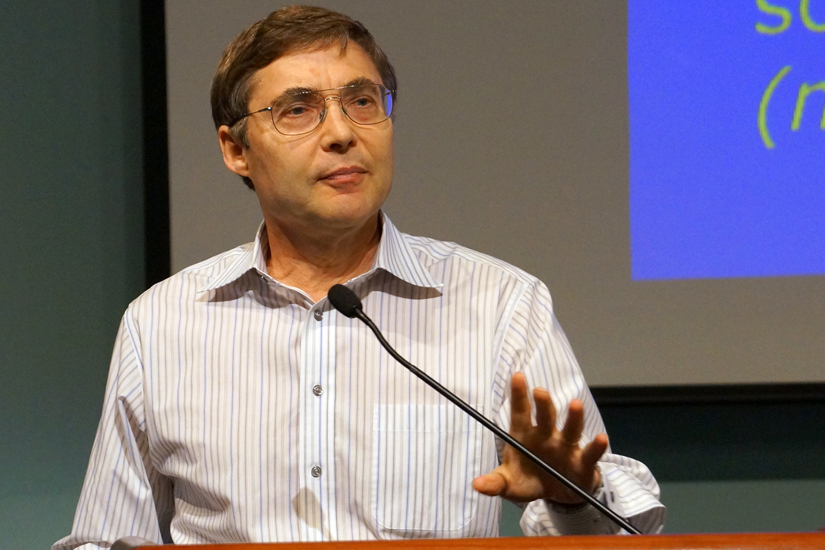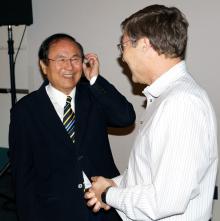
‘We Need Better Science and Engineering Education,’ Nobel Laureate Carl Wieman Tells Crowd

To be a successful teacher, you must understand how a student thinks. To be a successful student, you must learn how an expert thinks. That was a major part of the message delivered by Physics Nobel Laureate Carl Wieman at a public lecture at UC Santa Barbara's Corwin Pavilion Tuesday afternoon.
Titled "Taking a Scientific Approach to Science & Engineering Education," the well-attended lecture outlined an emerging, evidence-based method of teaching, specifically in the STEM (Science, Technology, Engineering and Mathematics) fields which have become a priority for public education in the United States. The talk was sponsored by the National Science Foundation's Robert Noyce Teacher Scholarship Program; Gale Morrison, acting dean of the Gevirtz Graduate School of Education; Pierre Wiltzius, dean of mathematical, physical and life sciences, in the College of Letters and Sciences; Rod Alferness, dean of the College of Engineering; Executive Vice Chancellor Gene Lucas; and Chancellor Henry T. Yang.
"It's clear in our society today: We need better science and engineering education for two big reasons," said Wieman, 2001 Nobel winner and director at the Carl Wieman Science Education Initiative at the University of British Columbia. "One is that the modern economy is so based on science and technology that you need more scientists and engineers for that economy to thrive; but we also need a more scientifically literate public to understand these important societal issues and decisions that we face in the world."
But conventional, teacher-centered methods of teaching science and engineering have been found to be less effective than newer, more interactive and collaborative methods, according to Wieman's research. The one-way transmission of information from teacher to student has been found lacking when compared to methods that include peer learning, constant monitoring and feedback, and activities that encourage thinking like scientists and engineers.
"There's no brain that comes in having these capabilities innately," Wieman said of the expertise that science and engineering students are expected to acquire –– capabilities that include a specific mental framework and the ability to monitor one's own thinking, in addition to vast factual knowledge. Designing challenging –– but not impossible –– tasks specific to the concept being taught, an awareness of student pitfalls, motivation, and timely feedback to guide thinking become the responsibilities of the teacher.
Such learning, meanwhile, also demands an investment of time, and greater levels of engagement and mental activity from the students. Most of the learning, said Wieman, will happen outside of the classroom, during homework and other activities meant to prime students into continuing to learn. Technology plays a role in various forms, from clickers used by students in the classroom, to the Internet for communication and interactive programs for learning and testing.
"To teach this way actually requires much more subject expertise than giving a traditional lecture," said Wieman. The range and depth of questions students are likely to ask in the more interactive environment is far greater than in a normal classroom, he said.
Wieman's lecture comes not only as the demand for well-qualified science and engineering faculty intensifies, but also as a new set of science education standards emerges in March, requiring K-12 science teachers to integrate engineering concepts into their curriculum.
"We really need more engineers to consider science teaching as a career," said Julie Bianchini, associate professor of education at the UCSB Gevirtz Graduate School of Education, and director of its National Science Foundation-funded Noyce CalTeach Physical Sciences & Engineering program. Students majoring in chemistry, physics, and engineering at UCSB are given opportunities to work with engineering academies at local high schools, while teacher candidates pursuing credentials in those fields may be eligible for a $20,000 Noyce Teacher Scholar Award.
The event also highlighted UCSB's strengths –– as a research university, for its Gevirtz School, and also for its interdisciplinary collaboration, with the focus of this event being the bridge between the sciences, engineering, and education.
"UC Santa Barbara is well-known for its highly collaborative and interdisciplinary environment," said Chancellor Henry T. Yang in his comments. "This is exemplified in this Noyce program, and in this inaugural cross-campus lecture."
Wieman's research, findings, and work in the field of science education might be inspiring changes at UCSB.
"It is not an accident that the deans are here," said Wiltzius, referring to himself and his colleagues from the College of Engineering and the Gevirtz Graduate School of Education. "This is incredibly important to us for a whole variety of reasons, and so whatever we can do to improve teaching and to make sure that we do a better job, we are all for it."
Related Links



